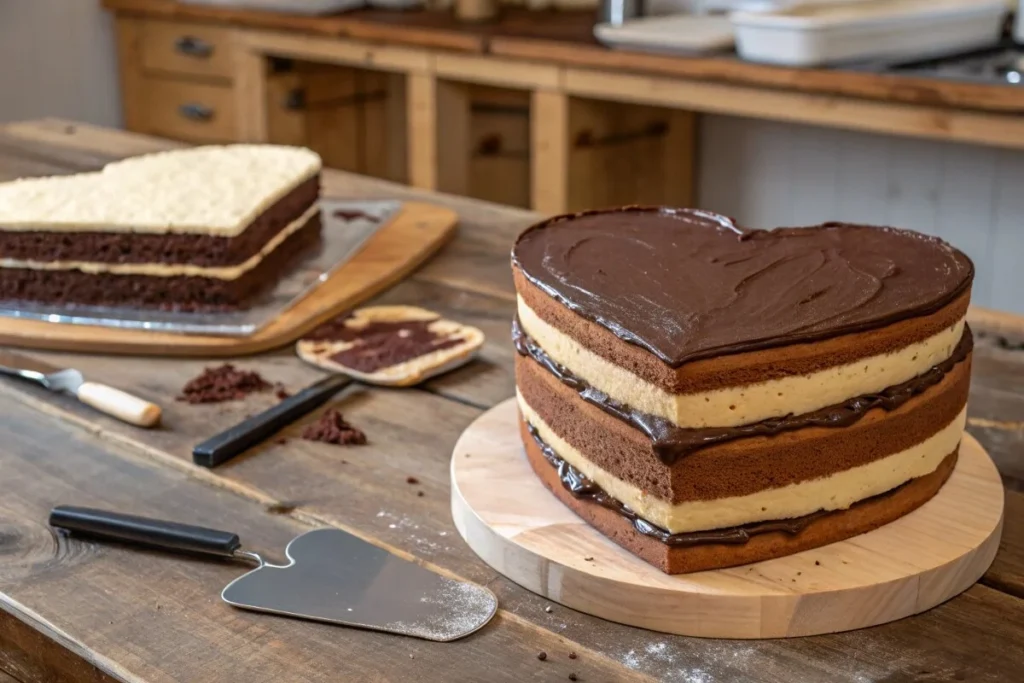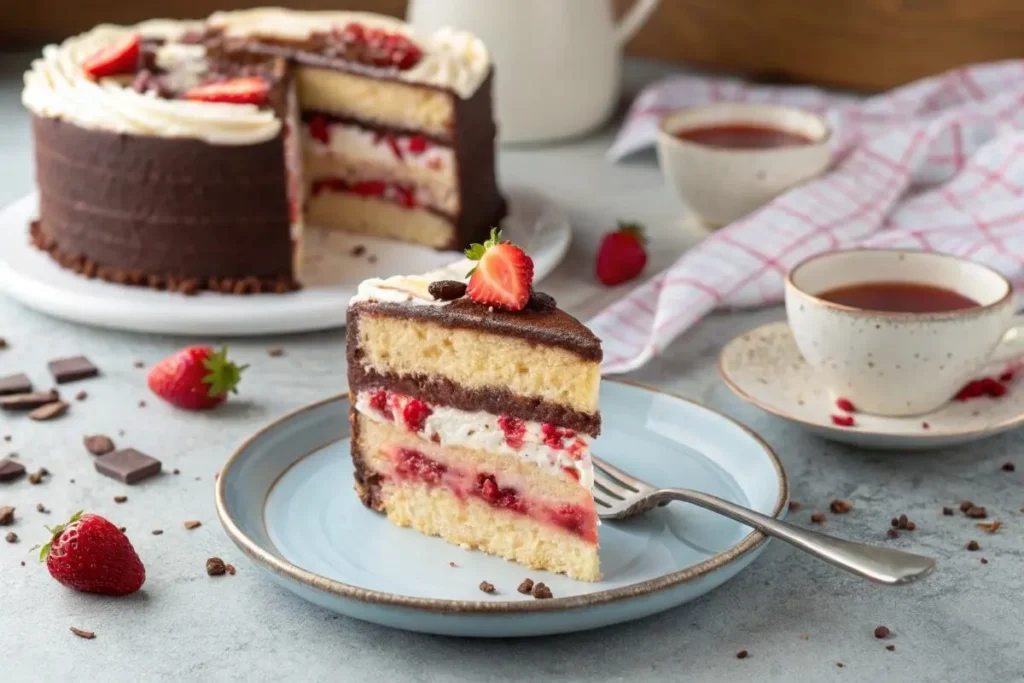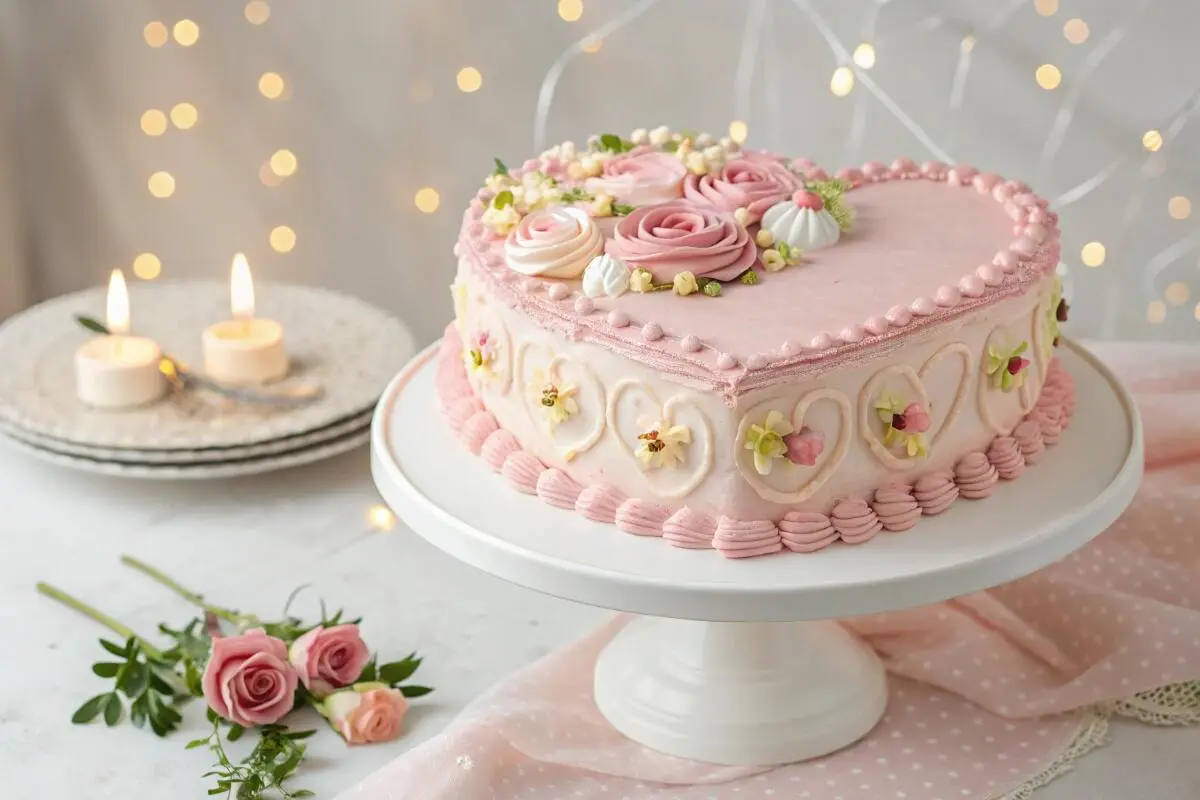How Many Layers Should a Heart Cake Have?
When it comes to crafting the perfect heart cake, the number of layers can make or break the final product. From birthdays to weddings, heart cakes are a charming way to add a touch of love to any occasion. But how many layers are just right? Should you stick to a single layer or go all out with three or more? In this guide, we’ll explore the factors influencing layer choices, discuss common configurations, and even share some tried-and-true layering tips and recipes. Whether you’re a seasoned baker or just starting, you’ll find all the answers here to create a heart cake that steals the show!
Understanding Heart Cake Layers
What is a Heart Cake?
A heart-shaped cake is exactly what it sounds like—a cake designed to resemble the universal symbol of love. Typically baked for special occasions like anniversaries, Valentine’s Day, or weddings, these cakes are as delightful to look at as they are to eat. Their iconic shape instantly sets them apart, making them an excellent choice for anyone wanting a dessert with a personal touch.
The Importance of Cake Layers in Heart Cakes
The number of layers in a heart cake significantly impacts its appearance, flavor, and serving size. More layers can add height and grandeur, making the cake visually stunning, while additional layers also allow for creative fillings like fruit compote, buttercream, or ganache. A single-layer heart cake might suffice for smaller, casual gatherings, but for bigger celebrations, multi-layer cakes are the way to go.
Adding layers also means more room for intricate decorations. With a well-structured, multi-layered cake, you can experiment with ombré frosting, textured designs, or even edible flowers.
Factors Determining the Number of Layers
Several factors influence how many layers your heart cake should have:
- Occasion: For intimate gatherings, a two-layer heart cake is elegant yet manageable. For weddings or grand events, three or more layers add a wow factor.
- Servings Needed: The more layers you have, the more slices you can serve. A taller cake is also easier to cut into uniform pieces, ensuring no guest is left out.
- Skill Level: Beginners might find single or double-layer cakes less intimidating. However, with practice, adding layers becomes an exciting creative challenge.
- Cake Pan Size: Heart-shaped pans come in various sizes. Matching the pan size to your layer goals ensures stability and an even bake.
With this foundation, you’re ready to explore common configurations for heart cakes in Part 2. Stay tuned for more baking tips and ideas!
How Many Layers Should a Heart Cake Have?
When it comes to crafting the perfect heart cake, the number of layers can make or break the final product. From birthdays to weddings, heart cakes are a charming way to add a touch of love to any occasion. But how many layers are just right? Should you stick to a single layer or go all out with three or more? In this guide, we’ll explore the factors influencing layer choices, discuss common configurations, and even share some tried-and-true layering tips and recipes. Whether you’re a seasoned baker or just starting, you’ll find all the answers here to create a heart cake that steals the show!
1: Understanding Heart Cake Layers
What is a Heart Cake?
A heart-shaped cake is exactly what it sounds like—a cake designed to resemble the universal symbol of love. Typically baked for special occasions like anniversaries, Valentine’s Day, or weddings, these cakes are as delightful to look at as they are to eat. Their iconic shape instantly sets them apart, making them an excellent choice for anyone wanting a dessert with a personal touch.
The Importance of Cake Layers in Heart Cakes
The number of layers in a heart cake significantly impacts its appearance, flavor, and serving size. More layers can add height and grandeur, making the cake visually stunning, while additional layers also allow for creative fillings like fruit compote, buttercream, or ganache. A single-layer heart cake might suffice for smaller, casual gatherings, but for bigger celebrations, multi-layer cakes are the way to go.
Adding layers also means more room for intricate decorations. With a well-structured, multi-layered cake, you can experiment with ombré frosting, textured designs, or even edible flowers.
Factors Determining the Number of Layers
Several factors influence how many layers your heart cake should have:
- Occasion: For intimate gatherings, a two-layer heart cake is elegant yet manageable. For weddings or grand events, three or more layers add a wow factor.
- Servings Needed: The more layers you have, the more slices you can serve. A taller cake is also easier to cut into uniform pieces, ensuring no guest is left out.
- Skill Level: Beginners might find single or double-layer cakes less intimidating. However, with practice, adding layers becomes an exciting creative challenge.
- Cake Pan Size: Heart-shaped pans come in various sizes. Matching the pan size to your layer goals ensures stability and an even bake.
With this foundation, you’re ready to explore common configurations for heart cakes. Stay tuned for more baking tips and ideas!
2: Common Layer Configurations for Heart Cakes
Single-Layer Heart Cake: When is it Enough?
A single-layer heart cake is perfect for small, casual celebrations. It’s quick to bake, easy to frost, and offers just enough servings for intimate gatherings. These cakes often serve as the canvas for simple yet elegant designs, such as a dusting of powdered sugar or a swirl of buttercream frosting. For beginner bakers, this is the ideal choice, requiring minimal tools and effort while delivering maximum charm.
Two-Layer Heart Cakes: A Perfect Balance
Two-layer heart cakes strike a harmonious balance between simplicity and sophistication. They provide the opportunity to add a filling—think fresh strawberries, cream cheese frosting, or even a tangy lemon curd. The extra layer also enhances the cake’s height, giving it a more professional appearance. Moreover, it’s a great choice for events where you need a little more cake but don’t want to commit to a multi-tiered masterpiece.
When assembling a two-layer heart cake, it’s crucial to ensure the layers are level. Uneven layers can lead to a lopsided cake, especially with heart shapes. Use a serrated knife or a cake leveler for best results.
Three-Layer and Multi-Layer Heart Cakes for Celebrations
For weddings, anniversaries, or milestone birthdays, three-layer or multi-layer heart cakes truly steal the spotlight. These cakes offer more room for creativity, whether through intricate piping, vibrant ombré designs, or a cascade of edible flowers. Heart cakes with three or more layers also allow you to experiment with complementary flavors—imagine chocolate, raspberry, and vanilla layers all in one stunning dessert!
That said, assembling taller cakes requires extra care. Dowels or supports may be needed to prevent the layers from sliding or collapsing. And don’t forget to let each layer cool completely before stacking—warm cakes can cause the frosting to melt and the layers to shift.
3: How to Create the Perfect Layers for Your Heart Cake

Choosing the Right Pan for Heart Cakes
Heart-shaped pans come in a variety of sizes, so selecting the right one is crucial. If you’re aiming for a multi-layered cake, make sure the pans are deep enough to hold a generous amount of batter. Alternatively, you can bake thinner layers in multiple pans to speed up the process. Non-stick pans or pans lined with parchment paper ensure your cake releases smoothly without tearing the delicate heart shape.
Preparing the Cake Batter for Even Layers
Achieving even cake layers starts with proper batter distribution. Measure your batter before pouring it into the pans to ensure each layer is equal. Use a kitchen scale for precision—this simple step can make all the difference in the final presentation. Additionally, consider using a cake strip around the pan; this handy tool helps the layers bake evenly without doming.
Tips for Leveling Cake Layers for Consistency
Leveling your cake layers is essential for stability, especially when working with multiple layers. A serrated knife or a dedicated cake leveler can help you trim any domes or uneven edges. For an extra professional touch, flip the layers upside-down before stacking—the bottoms are naturally flatter and easier to frost.
To add moisture and flavor, consider brushing the cake layers with a simple syrup before assembling. This trick is especially useful for cakes that will be served a day or two after baking.
4: Layering Techniques and Decoration Ideas
Stacking the Layers: A Step-by-Step Guide
When stacking cake layers, precision is key. Begin by placing the first layer on a sturdy cake board or plate. Spread a generous amount of frosting or filling evenly across the surface, ensuring it reaches the edges. For a heart-shaped cake, take extra care to cover the curves and crevices for a smooth look. Repeat this process for additional layers, ensuring each one is centered to maintain the heart shape.
To stabilize your layers, consider inserting dowels if your cake is more than three layers high. This simple step ensures that the cake remains upright, even during transportation.
Adding Filling Between the Layers
The filling is where you can let your creativity shine. Classic options like buttercream, whipped cream, or ganache are always popular. For a fruity twist, try fresh berry compote or lemon curd. For an extra indulgent cake, you can even add a layer of caramel or chocolate fudge.
To prevent the filling from seeping out, pipe a border of frosting along the edge of each layer before adding the filling. This technique creates a barrier that keeps everything in place while adding a polished look.
Decorative Ideas for Heart-Shaped Cakes
If you want to add an elegant finishing touch to your heart cake, check out our guide on how to pipe hearts on a cake for step-by-step instructions on creating beautiful designs
Decorating a heart cake is half the fun! A smooth buttercream finish is a classic choice, but textured frosting can add depth and charm. For special occasions like weddings or Valentine’s Day, adorn the cake with edible flowers, metallic sprinkles, or sugar pearls.
Another popular option is creating a gradient effect with tinted frosting, starting with a darker hue at the base and fading to a lighter shade at the top. If you’re short on time, a dusting of powdered sugar or cocoa over a heart-shaped stencil can also work wonders.
For more decoration ideas, check out similar cake recipe tutorials online to inspire your creativity!
5: Heart Cake Recipes to Try

Classic Vanilla Layered Heart Cake
This timeless recipe features moist vanilla sponge layers paired with creamy buttercream frosting. The layers are easy to bake, stack, and decorate, making it perfect for beginners. Adding a touch of vanilla extract or almond essence to the batter enhances the flavor.
Chocolate-Filled Heart Cake Recipe
For chocolate lovers, a heart cake layered with rich chocolate ganache is a dream come true. Start with chocolate sponge layers, then sandwich them with dark or milk chocolate ganache. For a finishing touch, drizzle melted chocolate over the top or sprinkle shaved chocolate for added texture.
Vegan Heart Cake: A Delightful Option
Vegan baking is easier than ever with this heart cake recipe. Swap out traditional ingredients for plant-based alternatives, like almond milk and flaxseed meal. Coconut cream makes a fantastic frosting base, and you can add natural food coloring for a vibrant look. This cake is so delicious, even non-vegans will be asking for seconds!
6: FAQs About Heart Cake Layers
How Many Layers Should a Heart Cake Be?
The number of layers in a heart cake depends on the occasion and your preferences. For smaller gatherings, a single-layer heart cake works beautifully. For a touch of elegance, a two-layer heart cake offers the perfect blend of height and flavor. However, for grand celebrations like weddings or anniversaries, three or more layers truly make a statement. Ultimately, the answer to how many layers should a heart cake have? lies in balancing aesthetics, servings, and practicality.
How Many Layers Should I Make My Cake?
When deciding on layers, consider the size of your guest list and the flavor experience you want to provide. A two-layer cake with a filling between the layers is a classic choice for most events. Adding more layers allows you to include varied flavors or create a dramatic visual impact, especially for special occasions.
How Many Slices Are in a 10-Inch Heart Cake?
A 10-inch heart cake typically serves 24 to 30 slices, depending on how it’s cut. If you want smaller portions, cut the cake into thin slices, which are ideal for rich, multi-layered cakes. For larger portions, you may get around 20 generous servings.
How to Cut a Heart-Shaped Cake Equally?
To evenly slice a heart-shaped cake, start by cutting it down the middle, dividing it into two halves. Then, cut each half into wedges, starting at the top and working your way to the bottom point. This method ensures that every piece is similar in size and shape.
7: Wrapping Up Your Heart Cake Journey
Crafting a heart cake is a labor of love that’s as rewarding as it is enjoyable. Whether you choose a single-layer cake for simplicity or a multi-layer masterpiece for grandeur, understanding how many layers a heart cake should have helps you create a dessert that’s both delicious and visually stunning.
Remember to experiment with flavors, fillings, and decorations to make your cake truly unique. And for more cake tips and inspiration, explore other baking guides to continue honing your skills. Your heart cake adventure doesn’t stop here—it’s just the beginning!
8: Tips for Baking and Stacking Perfect Layers
Start with the Right Ingredients
The foundation of a great heart cake lies in using high-quality ingredients. Fresh eggs, real butter, and premium flour create a tender and flavorful cake. If you’re adding fillings like fruit or cream, choose fresh and vibrant options to complement the cake layers. These small choices can elevate the taste of any heart-shaped creation.
Prep Your Layers Like a Pro
When figuring out how many layers a heart cake should have, precision is key. Start by ensuring your cake batter is evenly divided among the pans. After baking, allow the layers to cool completely before trimming or stacking. Using a serrated knife or a cake leveler helps create a flat, even surface, which is essential for stability when stacking multiple layers.
If you’re going for more than three layers, consider adding support, like dowels, to prevent shifting. This step is especially crucial for tall cakes or those with delicate fillings.
Part 9: Creative Inspiration for Heart Cakes
Layer Flavors for a Wow Factor
Why stick to just one flavor when you can create a medley? Layering different flavors—like chocolate, vanilla, and strawberry—gives each slice a dynamic taste. This technique works particularly well in multi-layered cakes, where each bite can tell its own story.
Decorating for the Occasion
Your decoration choices can transform a simple heart cake into a showstopper. For Valentine’s Day, think vibrant red and pink frosting, perhaps with heart-shaped sprinkles or edible roses. For weddings, elegant white fondant paired with gold accents adds sophistication. Use piping bags for intricate details, or add texture with a spatula for a rustic charm.
For bakers wanting to create a whimsical look, drip cakes are a fantastic option. Drizzle melted chocolate or caramel along the edges for a striking finish. No matter your choice, each design enhances the visual appeal of your heart cake.
By following these tips and letting creativity guide you, you’ll master the art of heart cakes in no time. Whether your cake has two layers or five, understanding how many layers should a heart cake have lets you craft desserts that are as delightful to look at as they are to eat.


2 thoughts on “How Many Layers Should a Heart Cake Have?”